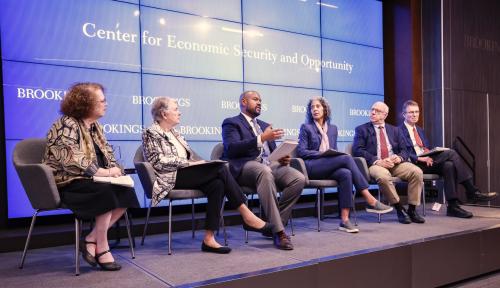Whenever Americans are polled about social welfare policies, two consistent themes emerge. Two-thirds or more of those surveyed say they support policies that help “the poor” who cannot help themselves—especially children, the elderly, and the disabled. And about two-thirds say that they do not support “welfare.” Americans consistently want government to lend a hand to those who cannot provide adequately for themselves—but only if it can do so without discouraging work and promoting dependence.
The distinction the public wants policymakers to draw between the deserving and the undeserving poor is often unworkable. Just as one example, the public generally believes that children deserve a helping hand. Yet society’s interest in preserving families means that we cannot help “deserving” children without also helping their parents—on whom Americans may be less willing to bestow that adjective.
Distinguishing between people who can work and those who cannot has also been more complicated for policymakers than it may seem. Just as a given individual’s employability can change, say, with the onset of illness—a perplexing complication for frontline welfare workers—so too has American society’s normative definition of employability evolved over the years. In the 1930s mothers were not expected to work. Today, work is the norm, even for mothers with small children.
Yet another conundrum for policymakers involves social welfare policies themselves: efforts to reduce poverty almost always have the unintended effect of reducing work effort. A central puzzle that has confounded policymakers since the English Poor Laws of the 1600s has been how to give money to families to support children without undermining their parents’ incentive to work and be self-supporting.
The evolution of U.S. welfare policy over the 20th century reflects these dilemmas. Originally, the aim of cash welfare for families was to provide enough income to enable widows to stay home and raise their children. In 1935, single mothers were grouped with the aged and disabled as people who should not be asked to work. As the population of single parents rose and became dominated by divorced, separated, and never-married mothers—a development that dramatically drove up welfare caseloads in the early 1970s—and as most women with children entered the labor market, welfare policy sought to balance two competing goals: providing cash support while requiring work to reduce parental welfare dependency.
The Welfare Tug-of-War
Since the 1970s, welfare policy has been a tug of war between those trying to protect children and families from penury and those who believe that welfare dependency is even worse for families than poverty is. Until the early 1990s, neither side was able to gain an edge. One side pushed to make welfare grants more generous, the other to strengthen the work requirement. Grants grew a little, but not enough, in most states, to match inflation. Congress tried repeatedly—in 1968, 1971, 1979, and 1988—to bolster work requirements. Nationally, welfare caseloads reflected the stalemate. Between 1975 and 1990, the number of families on welfare in any given month drifted between 3.5 million and 3.9 million or so.
In 1990 things changed. Welfare rolls began climbing, reaching nearly 5 million families by March 1994. Fears that welfare was discouraging work and marriage resurfaced with new urgency. Disillusioned that work requirements had not transformed the welfare state and alarmed by the surging welfare rolls, presidential candidate Bill Clinton promised to “end welfare as we know it.” Two years later the Republican-controlled Congress vowed to end welfare entirely.
The welfare law that passed in 1996 had two distinct personalities. On the one hand, it imposed time limits on benefit receipt (although states could exempt 20 percent of the caseload from those limits); placed strict work standards on the states, requiring that half of all welfare recipients be working by 2002; and told states to discourage out-of-wedlock childbearing, encourage marriage, and sustain two-parent families. On the other hand, it gave states primary responsibility for designing and implementing welfare programs, affording them tremendous flexibility in making those decisions.
Programmatically, what did the states do with their new responsibilities and flexibility? Most did three things. First, they emphasized “work first” (and deemphasized education and training) by requiring virtually all welfare recipients to begin searching for work immediately. Second, in a little noticed but potentially profound development, most states also helped to make work pay by allowing welfare recipients to keep more of their earnings without losing supplemental cash support. Recipients who took jobs could thus boost their incomes by combining low-wage work with welfare benefits. Third, states put limits on the number of months a family could receive welfare benefits, although the nature, enforcement, and thus the reality of those limits varied widely.
How effective were the new policies? By one measure—caseload reduction—they were remarkably effective. After peaking in March 1994, the welfare rolls fell by half, an unprecedented decline. But the downward trend began more than two years before the welfare reform bill passed and several years before the reforms were implemented in most states. Clearly good luck also played a role: the reforms coincided with the longest economic expansion in U.S. history.
How well are the new policies addressing welfare’s historic dilemmas? What effect are they having on parents’ employment and earnings, on families’ income and poverty status, and on children’s well-being? A large body of solid evidence on the three reform strategies—mandatory welfare-to-work programs, incentives to make work pay, and time limits—is providing early answers to those questions.
Mandatory Welfare-to-Work Programs
Since the late 1960s, when Congress first began to reorient the cash welfare program to focus on work, a cornerstone of policy has been to require welfare recipients to engage in employment and training services to remain eligible for benefits. States have deployed a range of strategies, including short-term job-search programs to help people get work quickly, longer-term education and training programs to augment human capital, and programs that mix elements from both models, sometimes in a fixed sequence, sometimes based on a caseworker’s assessment of skills and needs.
Mandatory welfare-to-work programs of all types have consistently increased employment and earnings and reduced welfare payments. Programs that have offered a mix of job search, education, and training typically chalk up the largest earnings gains (about $1,000 a year averaged across all people subject to a mandate), followed by job-search programs (a $600 increase), and then education programs (up $300).
Because these earnings gains were coupled with dollar-for-dollar cuts in welfare benefits, welfare-to-work programs typically saved public budgets more than they cost, an unusual accomplishment for social welfare programs. (The education programs have been an exception. Because they cost twice as much as job-search programs, their costs often exceeded welfare savings.)
But the government’s gains typically did not extend to welfare recipients. Their income generally remained unchanged because they lost $1 in benefits for every $1 increase in earnings. Furthermore, there is no evidence that parental employment either helped or harmed preschool or elementary school aged children.
Making Work Pay
Recognizing that people who left welfare for work were making no financial gain despite their increased effort, in the early 1990s a handful of states and localities set out to test policies that rewarded work. Though differing in their mix of benefits and services, all the policies offered monthly cash payments to supplement the earnings of low-income workers. The amount of the supplement depended on the earnings; payments went only to people who worked.
Results from these tests were encouraging, especially for long-term welfare recipients. Employment, including stable full-time employment, earnings, and income all rose. Because these gains came on top of existing work supplements such as the federal earned income tax credit for the working poor, there appears to be substantial room to make work pay more. Moreover, the employment and income gains led to consistent improvements in the well-being of children aged two to eleven, including higher test scores and better performance in school as judged by teachers and parents, as well as fewer behavioral problems and more positive behaviors.
In large part then, work incentives succeed where welfare-to-work programs do not, increasing income and employment and offering measurable benefits for children. But unlike welfare-to-work programs and because of the supplemental payments to workers, incentive programs usually cost more than they save.
Time Limits
Time limits establish welfare’s temporary nature and push recipients to take jobs and leave the rolls to preserve their lifetime months of eligibility. Rigorous studies of time-limited welfare tell a mixed story, confirming neither the right’s sunny promises of an end to dependency and its associated ills such as out-of-wedlock parenting nor the left’s worst fears of children sleeping in the streets.
Tests of programs resembling the three-pronged strategy most states have put in place—services to help recipients find jobs, cash payments to supplement earnings, and limits on the number of months a family could receive benefits—yielded unsurprising results. Initially, the programs reduced welfare benefits a little and modestly increased employment, earnings, and income. But when recipients ran up against the time limit, their income gains evaporated because welfare benefits could no longer supplement low earnings. The tests revealed little change in material hardship or harm to children, although the follow-up periods were generally short and the coping strategies used by those without jobs or benefits—relying on friends or charities—may not be sustainable for long, particularly in a weak labor market.
The Challenge Ahead
By the latter half of the 1990s, states were implementing a new generation of programs that promised to resolve welfare’s deserving- versus undeserving-poor conundrum and end its historic tug-of-war. Time limits and work requirements increased employment, reduced welfare receipt, and saved money, but did not reduce poverty or help children. States that were willing to spend more money to make work pay could help children without reducing work effort by their parents. To maximize the effectiveness of both time limits and incentives, states would have to find a way to reconcile the inherent conflict between the two: time limits push people to leave the rolls quickly, incentives hold them on welfare. They would also have to make decisions about administration (supporting the working poor within or outside of welfare), targeting (narrowly to welfare recipients or broadly to all working poor families), generosity (subsidy amount), and messages (ending welfare receipt while supporting the working poor).
Further complicating policymakers’ choices, none of the strategies states have pursued have turned out to be panaceas. Most welfare recipients who take jobs remain poor, suggesting that we have far to go in making work pay enough to lift the working poor out of poverty. Of equal concern, even the best programs leave many behind—40 percent or more by some estimates. In short, as welfare caseloads have declined, two new problems have come to the fore: how to buttress the low earnings and precarious job stability of the working poor (formerly the welfare poor) and how to address the myriad health-related barriers to employment of the hard-to-employ left behind on the rolls.
Next Steps for the Working Poor
Today the working poor are supported through an extensive patchwork of programs including the federal and state earned income tax credit programs, food stamps, various medical insurance programs, low-income day care programs, and the like. More than 40 states have also adopted some form of make-work-pay, usually a more generous earned income “disregard” by which the state doesn’t count a portion of earnings when calculating eligibility for welfare. Yet no single agency is responsible for helping the working poor get these benefits.
A Welfare-Based Strategy
While state disregards are more generous now than they once were, they differ from the successful make-work-pay programs discussed above in several ways. They are not as generous; they do not require full-time work; they are not marketed extensively; and they operate within the confines of time limits. States can address these problems by separating time-limit and incentive policies, by making incentives more generous when recipients work full-time, and by bolstering outreach. For example, Illinois stops its time-limit clock for someone who works full-time. Given the importance of full-time work for job retention and advancement, states that follow Illinois’s lead may also want to increase the generosity of incentive payments. In simulations substituting a larger earnings supplement and a full-time work requirement for the earned income disregards in effect before welfare reform, researchers found that employment, earnings, and income all grew substantially more than they have under states’ current earned income disregard policies.
Targeted primarily at welfare recipients, the net cost of such a program would probably be modest. Employment and earnings would likely rise, reducing public costs, and over time the work experience from more stable, full-time employment would likely raise earnings.
A Universal Strategy
A second way to make work pay more for poor workers is to use the TANF surplus and other federal funds to expand the earned income tax credit at the federal or state level. That would be more equitable than targeting welfare recipients only. But it might not increase employment and earnings as much because a universal strategy would have to provide less generous benefits and because many of those eligible for the expanded EITC would already be working, some full-time. Indeed, higher-earning families, particularly those who work a lot of overtime, may reduce their work effort somewhat. One solution would be to limit further increases in the EITC to full-time workers. But under that strategy employers would have to report wages and hours worked for all employees monthly, rather than quarterly, as now.
An Advancement and Retention Strategy
A third option is to try new approaches to career advancement and retention, including incumbent worker training and more intensive education and vocational training. A new generation of experiments involving employers, community colleges, and community-based organizations, just now getting under way, will build knowledge about what works in this area.
Next Steps for the Hard-to-Employ Left-Behind
Welfare recipients who cannot take advantage of welfare-to-work programs to find jobs and leave the rolls are likely to have even less education, fewer skills, and less work experience than the typical welfare recipient. Further complicating matters, surveys indicate that they are more likely to be clinically depressed and to have learning disabilities, health barriers (or children with such barriers), and substance abuse problems.
Because today’s social welfare system is not well equipped to address these disparate barriers, it will have to develop new partnerships with service providers who are. Yet we know little about what works, whether existing programs are adequate, or whether special programs for welfare recipients are necessary. To build this knowledge, policymakers would need to pursue three strategies.
One is to build new models for diagnosis and treatment. The first step would be to develop assessments that high-school-educated eligibility specialists can use to screen and identify applicants with a high probability of mental health, substance abuse, and learning disability problems. These assessments would have to be built into the application process for recipients reluctant to admit to such problems. Once problems are identified, recipients would be referred for a formal clinical assessment by trained professionals.
The next challenge is to select a treatment program appropriate for the kind and severity of the problem. A range of treatments is possible, but their effectiveness is unknown. For example, in the mental health area strong clinical evidence confirms the efficacy of antidepressant drugs and counseling. But little evidence exists about their efficacy in everyday settings for a broad cross-section of low-income people. This new generation of treatment programs will have to incorporate employment services and goals, address cultural differences that may make it less likely for low-income populations to take prescribed medications regularly, and redesign treatments to fit welfare’s more urgent time frame.
A second strategy would be a job of last resort. In a 1970s supported-work experiment, a subgroup of participants did reasonably well in supported work but could not graduate to private-sector employment. A similar group may well exist within the current welfare system. Policymakers will need to experiment with variations on the supported-work or sheltered-worksite model where the requirements of the job increase over time, with peer support built into the model along with specific strategies to address mental, physical, or other health and learning-related issues. Some people may be able to move into private-sector jobs over time. Others will exhaust their benefit eligibility and may require continued access to such work sites.
The third strategy is to define exemptions and reconsider the fraction of recipients who can be exempted. Federal law allows states to exempt up to 20 percent of the welfare caseload from time limits, but few states have defined those exemptions. According to anecdotal evidence from ethnographic research, a significant pool of people do not qualify for disability benefits but cannot meet the current welfare system’s work standards. A surprisingly common example is people undergoing treatment for cancer.
Both Sides Can Win
Make-work-pay policies allow policymakers to help poor children by increasing their families’ income without discouraging parental responsibility. And mandatory participation and time limits help reconcile a welfare system designed to support women when they did not work with new norms by which everyone is expected to work. Strategies to get these policies into better alignment, coupled with new efforts to increase the generosity of supports for the working poor while learning more about job advancement programs and about what works for the hard-to-employ, may just have what it takes to end welfare’s historic tug-of-war.



Commentary
The 30-Year Tug-of-War: Can Reform Resolve Welfare Policy’s Thorniest Conundrum?
June 1, 2001